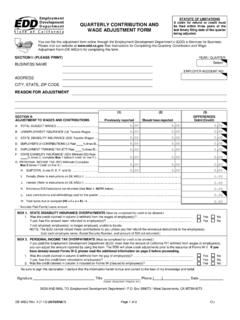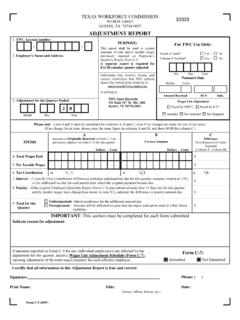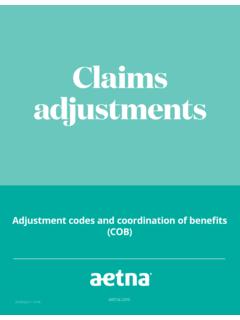Transcription of THE EFFECT OF STRUCTURAL ADJUSTMENT PROGRAMMES …
1 THE EFFECT OF STRUCTURAL ADJUSTMENT PROGRAMMES ON THE. DELIVERY OF VETERINARY SERVICES IN AFRICA. Animal Production and Health Division FAO, Rome, Italy January1999. HISTORICAL BACKGROUND TO SAPS. By the end of the 1970s, many sub-saharan African countries were in serious economic difficulties with high inflation, unmanageable balance of payments and fiscal deficits, GDP growth ratios below the rate of population increase. These difficulties have been attributed to excessive government intervention and control of the national economy. For example, prior to the middle 1970s, most States in Africa assumed complete responsibility for all animal health control measures. A full range of heavily subsidized services were brought to producers until financial crisis broke, leading to progressive deterioration of the quality of veterinary care and re-emergence of various epidemic diseases.
2 As funds became scarce, most states found it easier to make cuts in their operating expenses than in the numbers of staff. In many countries personnel cost reached more than 80% of the budget (Cheneau, 1985). To address these economic and financial problems, the IMF, World Bank and other international or bilateral donors urged and sponsored massive reforms, which have often included a set of macro-economic measures coupled with STRUCTURAL changes within the domestic economy. During the past decade, most countries in Africa have undertaken STRUCTURAL ADJUSTMENT programs (SAPs) of one form or another, which involved (i) currency devaluation, (ii) changes in fiscal, financial and pricing policy, and (iii) legal, regulatory and institutional reforms.
3 Changes in fiscal, financial and pricing policy included the elimination of subsidies and removal of tariffs while institutional reforms included privatization of government-owned enterprises and the introduction of cost-recovery. In seeking to move services from public to private sectors, donors argued that, in most domains, any form of private enterprise is likely to outperform the public sector. While SAPs have, to a certain extent, been successful in achieving the macro- economic changes, implementation of the accompanying micro or sectoral changes have been less successful (De Haan et al., 1991, Umali et al., 1992). There have been only a few studies on how SAP has affected the overall provision of services to farmers.
4 This paper seeks to specifically assess the impact of SAPs on the organization and delivery of animal health services in Africa. EFFECT OF SAPS IN SELECTED COUNTRIES. An attempt to evaluate the EFFECT of SAPs has been made through case studies carried out by the NGO V t rinaires sans fronti res in Guinea, Niger, Burkina Faso (BF). and Central African Republic (CAR) in 1994 (Thome et al, 1996) and through similar case studies commissioned by FAO carried out in Mali, Cameroon, Chad, Zimbabwe, 1. The EFFECT of STRUCTURAL ADJUSTMENT PROGRAMMES on the Delivery of Veterinary Services in Africa Namibia and Ghana in 1997 (Angniman, 1997, Ilemobade, 1996). Namibia did not undergo a SAP and in Zimbabwe veterinary services were not included in the SAP.
5 However, results obtained in these countries will be presented to serve as a point of comparison. The FAO case studies are based on missions undertaken by consultants to each of the countries. During these missions, information was obtained by detailed questionnaires and associated discussions with directors of Veterinary Services, government veterinarians, veterinarians in private practice, veterinary technicians, wholesalers of veterinary drugs, representatives of producers' organizations and other actors involved in the delivery of animal health care. Many of the findings in the countries visited are similar in many details, and to avoid undue repetition the common features will be summarized in tables and presented as a generalized overview.
6 Management Of The Privatization/Re-Structuring Process In few of the surveyed countries has the privatization/restructuring process of the national animal health services been approached in a systematic and concerted manner. In general, a top-down and at times erratic approach, in which the livestock producers and the private service providers have participated very little, if at all, has been adopted by the governments concerned. The process has been largely monopolized by government veterinarians, who had a vested interest in maintaining certain privileges. No serious attempts have been made to find appropriate solutions for the diversity of production systems, pastoral/communal areas, in the countries concerned.
7 CAR is an exception to this general rule. Here, the reform process was largely driven by the cattle breeders associations, who rely on the constant availability of trypanocides for the control of trypanosomiasis. As a result, the animal health service is to a large extent targeted to meet the needs of cattle producers, while other types of producers feel marginalised. Accompanying measures to stimulate the privatisation process (soft loans, training programs, the contracting out of services formerly carried out by public veterinarians). and incentives to leave government services (early retirement schemes, pension plans or other severance payments) have generally not been effectively put into place. There are indeed very few examples of government veterinarians leaving their post to set up a private enterprise.
8 Reform of existing legislation and formulation of new legislation and regulations concerning private practice, the role of public veterinarians and auxiliary staff, importation and distribution of drugs, etc. has been slow and occasionally inconsistent. In many countries opinions are split as to the contracting out of regulatory services to private actors and as to the circumstances in which clinical services can or should be provided by government veterinarians. Only in some countries has the private sector been involved in vaccination campaigns whereas in the other countries the fight against contagious diseases is still a monopoly of the public services. CAR is the only country where community animal health workers are 2.
9 The EFFECT of STRUCTURAL ADJUSTMENT PROGRAMMES on the Delivery of Veterinary Services in Africa officially recognized as part of the animal health delivery system. Violation of existing legislation, unauthorized sale of drugs, is rarely, if ever, sanctioned (In the West African countries included in the study, importation of drugs through unauthorized channels is estimated to be as high as importation through authorized channels.) NGOs and internationally-funded projects have been involved in free distribution of drugs, undermining efforts of privatization and cost-recovery. Thus, despite poor remuneration and not uncommon delays in payment by the government services, in most countries these remain the better alternative for many veterinarians compared with private practice, which is risky, requires up-front investment and, most importantly, is not shielded against unfair competition.
10 Overall, it appears that the consequences of privatization policies for veterinary service delivery have been a further neglect of duties previously executed by public services rather than their controlled transfer to the private sector. Evolution of Manpower The evolution of the number of veterinarians in government, private and other services between 1986 and 1996, as derived from the AHYBs, is presented in Table 1. As can be seen from the table, the number of veterinarians has increased in all countries, with the exception of Mali (see footnote), almost doubling if Mali and Namibia are excluded. Although the proportion of veterinarians in government service has generally been slightly reduced, the absolute number in government service has actually increased in all countries by around 20% if Mali is again excluded.


















